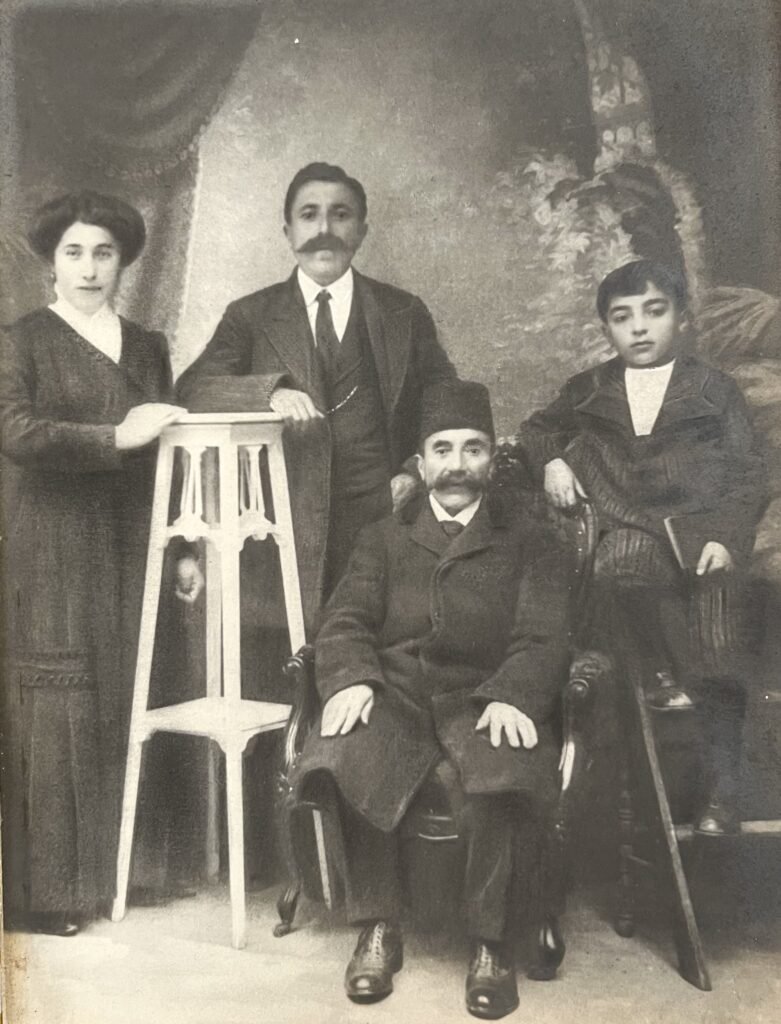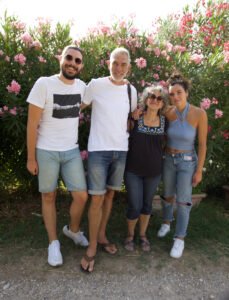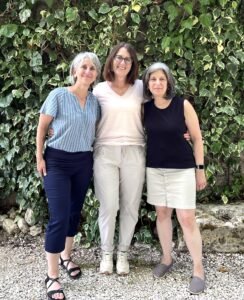
Part 1
In a world that often seems disconnected, with family histories lost to time and distance, I embarked on a journey to rediscover my paternal grandmother Lucy Shererian Bargamian’s roots. As an Armenian-American growing up in a close-knit family in the Providence community, I was always fascinated by my Armenian cultural heritage. However, it was the realization of the missing pieces in my family’s history, stemming from the trauma of the 1915 Armenian Genocide, that led to my inner desire to reclaim the lost family connections.
Being the grandchild of Genocide survivors, the weight of my family’s past was palpable. Stories were passed down to me of the sufferings and strength of my ancestors. My paternal grandmother, Lucy Shererian Bargamian, held a special place in my heart, even though I never had the chance to meet her. My medz mama Lucy was the sole Shererian in her immediate family to survive the Genocide and find refuge in the United States. The horrifying memories of witnessing the murder of her parents and sisters were the painful burdens she carried with her every day. Lucy’s first cousin Kegham, paternal uncle Vahan, aunt Yeranouhi, and possibly her grandfather (my great-great-grandfather) survived and ended up in Nice, France, and then Marseille.
My husband Tom and I had talked about a trip to Marseille for quite some time. The thought of finding this thread of my family got under my skin. Driven by a deep yearning to uncover my family’s history, I embarked on a quest to find the descendants of my grandmother’s first cousin, Kegham Chehrerian. My research led me to various social media platforms, where I reached out to anyone bearing the name Chererian or Shererian, hoping for a connection. At first, many remained silent.
Undeterred, I persisted.

While researching in Chicago, I struggled to make progress because of how my family spelled Shererian. I understood that the French spelling would be different, using “Ch” instead of the “Sh” my paternal grandmother Lucy used. I was getting nowhere in my search for the names Shererian and Chererian.
During the 1930s and 1940s, Lucy and Kegham wrote to one another. Over time, the letters stopped, possibly due to address changes. I needed to review the writing on envelopes written by Kegham. I reached out to my brother Charles, who found an envelope our family stored away for many years. I saw the envelope through my brother’s text message and noticed that Kegham had added an extra letter to his last name. I assumed the French version would be Chererian, but it was spelled Chehrerian on the envelope. Using the second “h” proved key in making progress with my search. Remember, even a single letter can make a significant difference.
At the time, another “breakthrough” came from the old envelope with Kegham’s address, as a map showed that Kegham lived across the street from an Armenian church in Marseille. It seemed like a promising path that would lead me to Kegham’s descendants, my cousins. I believed the church would have a record of its parishioners, including Kegham. Excitement surged as I corresponded with a priest in Marseille, who offered to connect me with a church community member upon our arrival. My dream of meeting my Chehrerian family was within reach as my husband and I meticulously planned our 2022 summer trip across France.
Arriving in Nice, the research engines finally gave me a glimpse into Kegham Chehrerian’s life. Discovering Kegham’s obituary, which mentioned his residence in Marseille and his birthplace in the village of Osnag/Keghi, was a moment of triumph. Thoughts of my father Charles and his siblings, all of whom have passed on, filled my heart. Were they unaware of their mother’s Chehrerian family that had been there all along? We explored Marseille a bit, then went to the church on Grand Pins, where I had hoped to find the missing pieces of my family puzzle.
We rushed to Grand Pins, thinking it was Kegham’s former residence. We soon discovered that Kegham had lived on a different Grand Pins in another neighborhood about three miles away. Nevertheless, since this active church was built in 1929, Kegham likely attended this Armenian church with his family. It soon became apparent that the Armenian population in that area had dispersed over the years, and the community members we met did not know of any Chehrerians.
What initially seemed like a setback blossomed into a beautiful encounter with Murad and Berjouhi, members of the church community whose father built the church. Their warm hospitality and stories of their family’s direct involvement in the Armenian church provided solace against temporary disappointment. Though the elusive connection with Kegham’s descendants remained, the bonds forged with Murad and Berjouhi have endured. (Berjouhi and I have been in frequent contact. I host The Medz Mamas podcast, and Berjouhi, who happens to be a highly spirited ninety-year-old, is honoring her medz mama Manning in an upcoming episode.)
Marseille, France – It was a bittersweet moment as we said au revoir to Marseille, a city that had both frustrated and inspired me during my search. While disappointment filled me, my husband Tom’s unwavering support echoed in my ears, urging me not to give up. Little did I know that the universe had something in store for me just beyond the horizon.
Transitioning from public transportation to a more intimate mode of travel, Tom took the wheel as we departed Marseille, venturing into the countryside. We headed to Saint-Remy-de-Provence, a picturesque town serving as a gateway to a tapestry of neighboring gems. Arles, Antibes, Aix-en-Provence, Avignon and Nimes alone evoke a sense of timeless beauty. The rolling hills leading to Cezanne’s atelier, the lovely lavender fields and the sensual open-air markets are the memories that continue to play in my mind. Saint-Remy-de-Provence is an ideal hub for those exploring Provence, providing easy access to many villages. The cuisine seduces the senses at every turn.
While in Provence, the search for my Chehrerian relatives continued. As I began to think the entire quest was futile, fate intervened. A late-night iMessage illuminated my phone screen two days before bidding farewell to Saint-Remy-de-Provence. It was the message I had longed for—an eagerly awaited response from my cousin Thomas Chehrerian, whom I had contacted the week before during our stay in Marseille. “Hello Anoush. Yes, Kegham was my great-grandfather, but I never knew him.” I read his words several times. Late-night exchanges, early-morning conversations and a planned rendezvous in Saint-Remy-de-Provence marked the beginning of our long-awaited reunion. I would finally reunite my family, torn apart due to genocide over a century ago.

Finally, the day arrived, and I got to meet my cousins. The thought of a reunion had me floating on cloud nine. Determined to make this visit extraordinary, my husband and I found the open-air market, searching for many mezze delights. We wanted to create an exceptional experience when we finally connected with our extended family.
Located in the enchanting town of Saint-Remy-de-Provence, we had a picturesque setting in the garden of our temporary abode. From their home in Aix-en-Provence, a mere hour to an hour and a half away, our cousins embarked on their journey to meet us. The eagerness to reunite and share our family history fueled our spirits. And then, as if on cue, the unmistakable sound of a car pulling up on the gravel reached my ears. It was the anticipated arrival of my cousins.
As they stepped out of the car, what struck me immediately was the towering height of my cousins Claude and his son Thomas. Then, I realized the origin of my father’s long legs and stature, hailing from my dad’s maternal Chehrerian lineage.
Introductions began, guided by my twenty-something cousin Thomas. The family came together—Margot, Thomas’s sister, their father, Claude, and their mother, Corrine. Claude, their father, and I belong to the same generation, while their children belong to my children’s generation. Conversations flowed ceaselessly, weaving tales and anecdotes about our shared heritage. Claude took it upon himself to draw a detailed family tree, shedding light on our intricate connections. I learned that Kegham had three sons: Francois, Henri and George. It was Henri’s line of the family we were meeting, i.e., Claude and his wife Corrine, Thomas and Margot. In return, I proudly shared cherished photos of my family, neatly stored on my iPad. The communication flowed, aided by the bilingual abilities of Claude’s family, enabling us to bridge the gap despite our limited French.
A particularly heartwarming moment arose when Margot dialed her grandfather Henri, who resides in Nice. With the Armenian I know, I conversed briefly with Henri, who said he had forgotten some of his Armenian over time. Once a fluent speaker, he had spoken in Armenian with his father Kegham and his mother Yeranouhi. (Kegham was born in 1905 in Osnag/Keghi and passed away in 1997 at 92 in Marseille.) The joy in Henri’s voice upon hearing from his granddaughter Margot and knowing we were all together was unmistakable. Henri had heard about Lucy, his cousin from Osnag/ Keghi, who had settled in the United States, from his father Kegham. Claude also knew about having US cousins from his father Henri.
As our visit was ending, we decided to capture the memory of this reunion through photographs, promising to continue our newly-rekindled relationships.
Last fall, another family member responded to the message I had sent out the previous summer. My cousin Annie Chehrerian, who also resides in France, has become a “friend” of mine via social media. In our correspondence, Annie shared captivating photographs of our family: her grandfather Kegham (my cousin); her great-grandfather Vahan (my great-granduncle Vahan) and his wife Lucig; and even our great-great-grandfather Chehrerian. The discovery of my great-great-grandfather’s image left me in awe. It was a profound moment, unveiling a missing piece of my family puzzle—one I never expected to find.
My journey of discovery continues through Annie as we explore our shared roots. It fills me with profound gratitude that I have made my medz mama Lucy proud, alongside my father Charles, my uncles, aunt, siblings, children, nieces, nephews and cousins. Through perseverance and determination, I encourage each of you, dear readers, to follow the threads of your family tree. Embrace the joy that comes from unraveling your personal history, for it has the power to enrich your heart and soul.
Part 2
The upcoming month marks the beginning of another heartwarming Chehrerian reunion. Joining me on this trip to France will be my beloved husband and sister Georgi. We eagerly look forward to meeting our Chehrerian cousins.
I hope to learn more about Kegham’s journey and what happened to our great-great- grandfather Chehrerian. In the meantime, I’ll share what I know of my medz mama Lucy’s journey with you.

Lucig’s parents (my great-grandparents) Megerdich and Markerid and her four sisters lived a whole life in Osnag/Keghi, Western Armenia. Medz mama Lucy’s parents and sisters fell victim to the 1915-1923 Armenian Genocide. Before the Genocide, Lucig’s husband Bargham Bargamian had already left the village of Osnag/Keghi and departed for the United States to send money back home.
Lucig and her eldest son, my uncle Khatchadoor, were forced to bear witness to the merciless slaughter of their entire family at the hands of Turkish soldiers. My Uncle “Hatchie” saw his grandfather Megerdich brutally struck with an ax to the head in a horrifying act. Seeking refuge, my grandmother Lucig and her two sons, my uncles Khatchadoor (12 years old) and Hovannes (10 years old), sought shelter in the basement of a sympathetic Turkish neighbor for nearly a year.
Their lives took a hopeful turn when Armenian soldiers came to their rescue guiding them to the train station. They embarked on a train journey to Alexandropol, known today as Gyumri, Armenia. At Alexandropol, Lucig and her sons found solace in an *orphanage, where Lucig’s husband Bargham eventually located them.
Bargham, who resided in North Providence, Rhode Island, had learned about the Armenian Genocide through news reports and friends in the Armenian community. Driven by a profound desire to find his family, he returned to his devastated homeland. After a long-awaited reunion in Alexandropol, they left the orphanage behind at some point and embarked on a northbound train journey through Russia, eventually reaching Norway.
Adding to the already immense trauma experienced by medz mama Lucy and my uncles, a new obstacle emerged when they arrived in Norway. My uncle Hovannes (Johnny) failed an eye exam due to an “eye deficiency.” As a result, he had to remain in Norway for four years under the care of his aunt Zarmig Bargamian.
From Norway, part of the family continued their voyage to Liverpool. The boat voyage from Liverpool posed further challenges for medz mama Lucy, who was expecting her third child, my dad Garabed (Charles). Throughout the two-week journey, she battled constant sickness. They sailed across the Atlantic to Ellis Island in New York. Their ultimate destination and new home became North Providence, Rhode Island, where they settled. They arrived in Rhode Island in mid-November 1917, and shortly after that, on December 4, 1917, medz mama Lucy gave birth to my father.

Medz mama Lucy passed away a year before I was born. The one thing that always stood out was that she persevered and had a whole life after the Armenian Genocide. Together, my grandparents Lucig and Bargham had four children: Khatchadoor (Archie), Hovannes (Johnny), Garabed (Charles) and Margaret (Parantzem). They lived on a farm in North Providence, and the farm remained in the family for many years. Before picnics at Camp Haiastan in Franklin, Massachusetts, this is where Armenians in the New England area would gather, break bread and spend hours dancing to Armenian folk music. Non-Armenians in the neighborhood knew the Bargamians as friendly and generous folks, especially during the depression, often giving food away.
As the offspring of Garabed (Charles) Bargamian and Pearl Hajian Bargamian, I, along with my siblings (Georgi, Pearl and Charles), take immense pride in perpetuating our family legacy and contributing to the vibrancy of our respective communities. Our connection to our family’s story is an integral thread in the rich tapestry of our Armenian identity and the broader human experience. Through first-hand experiences, we honor the significance of our ancestral heritage, driving us to forge ahead with determination and love. To be continued.
*During the Armenian Genocide from 1915 to 1923, Alexandropol became known as the city of 40,000 orphans. Thirty-nine buildings were allocated to house the surviving women and children. Presently, one of these buildings, where all survivors once passed through, continues to serve as an orphanage in modern-day Gyumri, Armenia. In 2017, my older son Aris and I had the opportunity to visit the Terchoonian Home Orphanage, which holds profound significance for my family.
Being present in that space, where countless Armenian survivors were processed, including our relatives, left an indelible mark on both of us.



What an amazing story, Anoush! Thank you so much for sharing.
Beautiful! Thank you for sharing
beyond the family tree, Anoush, you have captured the journey on a map of survival – both for your ancestors in the past and for you in the present as a timeless bridge
What a beautifully written article!
Big Fat Thank You. I am in tears.
Really enjoyed your journey and discovery. Your perseverance to locate your family across continents and other challenges is a true testament to our Armenian will to survive. Thank you, Anoush, for sharing your story and inspiring others to do the same. And a huge shoutout to your husband Thomas for his unwavering support and encouragement!